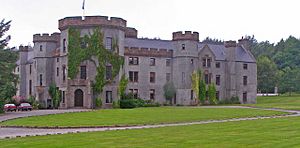Fetteresso Castle facts for kids
Fetteresso Castle is a 14th-century tower house, rebuilt in 1761 as a Scottish Gothic style Palladian manor, with clear evidence of prehistoric use of the site. It is situated immediately west of the town of Stonehaven in Kincardineshire, slightly to the west of the A90 dual carriageway. Other notable historic fortified houses or castles in this region are Dunnottar Castle, Muchalls Castle, Fiddes Castle, Cowie Castle and Monboddo House.
Prehistory
From cropmarks in the "policies" (improved areas) around Fetteresso Castle, there is evidence of a ring-ditch sited at the north end of a cursus. A cursus is a prehistoric set of parallel linear structures of unknown purpose that were, somewhat fancifully, considered by antiquarians as used for some type of athletic competition, possibly related to hunting or archery; this is unsubstantiated. In 1822 a cairn was discovered near Fetteresso Castle with some human remains inside. The size and shape of the chamber made of unhewn whinstone clearly show that the burial site was a Bronze Age construct. Some legends tell that this is the grave of Malcolm I, who is recorded to have been slain at Fetteresso in 954 AD. The burial hillock has become known as Malcolm's Mount, even though it is not likely from current archaeological analysis that the crypt could be so recent. In 1998 a burial urn from the Beaker people was found at Fetteresso Castle. The Roman Camp of Raedykes is located several miles northwest, where a full legion encamped and many archeological recoveries have been made. This location is one of a string of marching camps that connected Angus to Moray.
Middle Ages
The property is recorded to have been owned by the Strachans.
Robert de Bruce opposed the Balliol (and later the Comyn) claim to the throne of Scotland, which culminated at the Battle of Barra Hill (1308). Castlehill of Strachan was in fact burned out by Robert de Bruce, and the Barony of Strachan later disinherited from the de Strachan family and granted by Robert de Bruce to Sir Alexander Fraser in c. 1316 (Robertson Index, 1-15). The Strachan family were supporters and kinsmen of John Comyn, Earl of Buchan.
The barony of Fetteresso eventually passed to William Keith, the Earl Marischal of Scotland, who inherited the barony through his mother, the daughter of Sir Alexander Fraser in the 14th century to the Clan Keith Earls Marischal, who built the tower house. The Earls Marischal also held the nearby fortress, Dunnottar Castle.
17th and 18th centuries
The characteristic Scottish designs of crow-stepped gables and the battlement crenellation elements were introduced. A dovecote of considerable height was constructed in the 17th century to the south of the castle. In 1659 Jean Hunter lived at Fetteresso. She was accused of witchcraft and hanged at her home. An artist and wright named Alexander Charles worked at Fetteresso as an overseer. Charles flourished in 1671 to 1678 and published his drawings in at least one book. Late in the 17th century, the Duff family controlled Fetteresso and expanded the building around the old tower house.
20th and 21st centuries
In the 1940s, the castle was owned by Maurice Simpson and Geraldine Simpson (née Pringle). She was the heir to the Pringle knitware fortune. Subsequently, the Simpsons acquired and lived in nearby Muchalls Castle. After the Simpsons' tenure at Fetteresso, the roof was off the castle for some period starting around 1954, and the castle bought by a local landowner and then left to the Don family in his will. In the latter part of the 20th century, the castle was restored, greatly modified, to yield seven houses, which is its present use. As of 2006 Mrs Simpson still resides in the local area.


